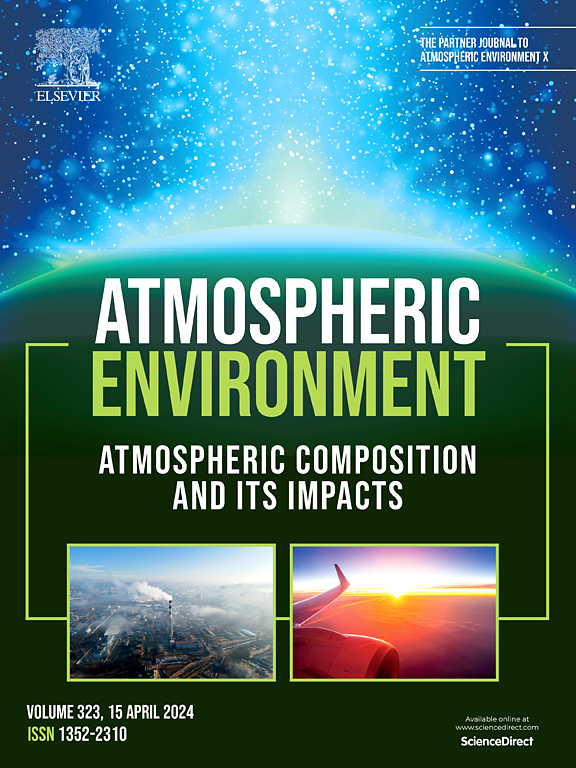Insights into surface ozone variability in India (1980–2014) through CMIP6 model analysis
IF 4.2
2区 环境科学与生态学
Q2 ENVIRONMENTAL SCIENCES
引用次数: 0
Abstract
This study investigates long-term (1980–2014) surface ozone (O3) variability over India using Coupled Model Intercomparison Project Phase 6 (CMIP6) models, offering a comprehensive spatial assessment crucial for addressing air quality and climate change challenges. Model outputs were compared with Atmospheric Infrared Sounder (AIRS) derived surface O3 to evaluate their reliability. Results reveal a persistent north-south gradient in surface O3, with higher values over northern India, consistent with satellite data. Most models indicate a positive trend in surface O3 across the country, while a negative trend is identified over parts of the central Indo-Gangetic Plain (IGP), a previously unreported phenomenon. Analysis of precursor gases shows significant positive trends over India, with the IGP emerging as a hotspot. Spatial correlations between surface O3 and its precursors highlight regional heterogeneity and complex formation dynamics. VOC-limited regimes dominate across India, whereas NO/NO2-limited chemistry prevails in the IGP, explaining the decreasing trend of surface O3 despite rising NO/NO2 emissions. Among the CMIP6 models, CESM2-WACCM-FV2 is identified as the most reliable for studying surface O3 in India. The spatial distribution provided by CMIP6 models is particularly valuable in regions lacking long-term monitoring, where ground-based observations are limited to point-based measurements. This study underscores the critical role of CMIP6 models in understanding surface O3 variability and highlights the utility of satellite-derived data as a complementary resource. The findings provide actionable insights for policy efforts to mitigate surface O3 and its precursors, improving air quality and addressing climate challenges in India.

通过CMIP6模式分析印度地表臭氧变化(1980-2014
本研究利用耦合模式比对项目第6阶段(CMIP6)模型调查了印度地表臭氧(O3)的长期(1980-2014)变化,为应对空气质量和气候变化挑战提供了一个全面的空间评估。将模型输出与大气红外探测仪(AIRS)得到的表面O3进行比较,以评估其可靠性。结果显示,地表O3存在持续的南北梯度,印度北部的数值较高,与卫星数据一致。大多数模式表明,全国各地的地表臭氧呈正趋势,而印度-恒河平原中部部分地区则呈负趋势,这是以前未报道的现象。对前驱气体的分析显示,印度上空有显著的积极趋势,IGP正在成为热点。表层O3与前驱体的空间相关性突出了区域异质性和复杂的地层动力学。vocs限制制度在印度占主导地位,而NO/NO2限制化学在IGP占主导地位,这解释了尽管NO/NO2排放增加,但表面O3呈下降趋势。在CMIP6模式中,CESM2-WACCM-FV2被认为是研究印度表面O3最可靠的模式。CMIP6模式提供的空间分布在缺乏长期监测的地区尤其有价值,在这些地区,地面观测仅限于基于点的测量。本研究强调了CMIP6模型在理解地表O3变化方面的关键作用,并强调了卫星数据作为补充资源的效用。这些发现为政策努力提供了可行的见解,以减少地表臭氧及其前体,改善印度的空气质量和应对气候挑战。
本文章由计算机程序翻译,如有差异,请以英文原文为准。
求助全文
约1分钟内获得全文
求助全文
来源期刊

Atmospheric Environment
环境科学-环境科学
CiteScore
9.40
自引率
8.00%
发文量
458
审稿时长
53 days
期刊介绍:
Atmospheric Environment has an open access mirror journal Atmospheric Environment: X, sharing the same aims and scope, editorial team, submission system and rigorous peer review.
Atmospheric Environment is the international journal for scientists in different disciplines related to atmospheric composition and its impacts. The journal publishes scientific articles with atmospheric relevance of emissions and depositions of gaseous and particulate compounds, chemical processes and physical effects in the atmosphere, as well as impacts of the changing atmospheric composition on human health, air quality, climate change, and ecosystems.
 求助内容:
求助内容: 应助结果提醒方式:
应助结果提醒方式:


